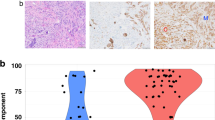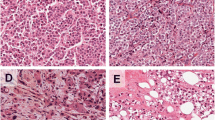Abstract
Although invasive ductal (IDC) and lobular (ILC) breast carcinomas are well characterised in the literature, the biological and clinical significance of mixed tumours with both ductal and lobular components has not been investigated. In the current study, we have examined a well-characterised series of breast carcinoma with a long term follow-up that comprised 140 mixed tumours, 2170 IDC and 380 pure ILC. Results: Mixed tumours constituted 3.6% of all cases. The majority (59%) of the mixed tumours were grade 2 compared to 33% in IDC and 88% in ILC. Positive lymph nodes (LN) were found in 41% and definite vascular invasion (VI) in 26% of the cases. DCIS was detected in 123 (89%) and LCIS in 43 (31%) (both DCIS and LCIS were found in 39 cases). The majority of tumours were predominantly (>50 of tumour area) of ductal type (57%). When compared to pure IDC, mixed tumours showed an association with lower grade, ER positivity and lower frequency of development of distant metastases. When compared to pure ILC, mixed tumours showed an association with higher grade, positive LN metastasis, VI and development of regional metastasis. After adjustment for grade most of these differences were no longer apparent. There was an association between histologic type of carcinoma in LN metastasis and the predominant histologic type of the primary tumour. Mixed tumours showed metastatic patterns similar to that of ILC with frequent metastasis to bone. No clinically meaningful differences in survival were found between these mixed carcinomas and pure IDC or ILC of the breast or between mixed tumours with predominantly ductal or lobular phenotype.


Similar content being viewed by others
References
Sastre-Garau X, Jouve M, Asselain B et al (1996) Infiltrating lobular carcinoma of the breast. Clinicopathologic analysis of 975 cases with reference to data on conservative therapy and metastatic patterns. Cancer 77(1):113–120
Lamovec J, Bracko M (1991) Metastatic pattern of infiltrating lobular carcinoma of the breast: an autopsy study. J Surg Oncol 48(1):28–33
Arpino G, Bardou VJ, Clark GM, Elledge RM (2004) Infiltrating lobular carcinoma of the breast: tumor characteristics and clinical outcome. Breast Cancer Res 6(3):R149–R156
Borst MJ, Ingold JA (1993) Metastatic patterns of invasive lobular versus invasive ductal carcinoma of the breast. Surgery 114(4):637–641. Discussion 41–42
Li CI, Anderson BO, Daling JR, Moe RE (2003) Trends in incidence rates of invasive lobular and ductal breast carcinoma. JAMA 289(11):1421–1424
Ellis IO, Galea M, Broughton N et al (1992) Pathological prognostic factors in breast cancer II. Histological type. Relationship with survival in a large study with long-term follow-up. Histopathology 20(6):479–489
Reeves GK, Beral V, Green J, Gathani T, Bull D (2006) Hormonal therapy for menopause and breast-cancer risk by histological type: a cohort study and meta-analysis. Lancet Oncol 7(11):910–918
Li CI, Anderson BO, Porter P et al (2000) Changing incidence rate of invasive lobular breast carcinoma among older women. Cancer 88(11):2561–2569
Molland JG, Donnellan M, Janu NC et al (2004) Infiltrating lobular carcinoma—a comparison of diagnosis, management and outcome with infiltrating duct carcinoma. Breast 13(5):389–396
Yoder BJ, Wilkinson EJ, Massoll NA (2007) Molecular and morphologic distinctions between infiltrating ductal and lobular carcinoma of the breast. Breast J 13(2):172–179
Rakha EA, El-Sayed ME, Powe DG et al (2008) Invasive lobular carcinoma of the breast: Response to hormonal therapy and outcomes. Eur J Cancer 44(1):73–83
Li CI, Daling JR, Malone KE et al (2006) Relationship between established breast cancer risk factors and risk of seven different histologic types of invasive breast cancer. Cancer Epidemiol Biomarkers Prev 15(5):946–954
Cleton-Jansen AM (2002) E-cadherin and loss of heterozygosity at chromosome 16 in breast carcinogenesis: different genetic pathways in ductal and lobular breast cancer? Breast Cancer Res 4(1):5–8
Korkola JE, DeVries S, Fridlyand J et al (2003) Differentiation of lobular versus ductal breast carcinomas by expression microarray analysis. Cancer Res 63(21):7167–7175
Sarrio D, Perez-Mies B, Hardisson D et al (2004) Cytoplasmic localization of p120ctn and E-cadherin loss characterize lobular breast carcinoma from preinvasive to metastatic lesions. Oncogene 23(19):3272–3283
Tubiana-Hulin M, Stevens D, Lasry S et al (2006) Response to neoadjuvant chemotherapy in lobular and ductal breast carcinomas: a retrospective study on 860 patients from one institution. Ann Oncol 17(8):1228–1233
du Toit RS, Locker AP, Ellis IO et al (1991) An evaluation of differences in prognosis, recurrence patterns and receptor status between invasive lobular and other invasive carcinomas of the breast. Eur J Surg Oncol 17(3):251–257
Yeatman TJ, Cantor AB, Smith TJ et al (1995) Tumor biology of infiltrating lobular carcinoma. Implications for management. Ann Surg 222(4):549–559. Discussion 59–61
Ferlicot S, Vincent-Salomon A, Medioni J et al (2004) Wide metastatic spreading in infiltrating lobular carcinoma of the breast. Eur J Cancer 40(3):336–341
Winston CB, Hadar O, Teitcher JB et al (2000) Metastatic lobular carcinoma of the breast: patterns of spread in the chest, abdomen, and pelvis on CT. AJR Am J Roentgenol 175(3):795–800
Cocquyt VF, Blondeel PN, Depypere HT et al (2003) Different responses to preoperative chemotherapy for invasive lobular and invasive ductal breast carcinoma. Eur J Surg Oncol 29(4):361–367
Ashikari R, Huvos AG, Urban JA, Robbins GF (1973) Infiltrating lobular carcinoma of the breast. Cancer 31(1):110–116
Mate TP, Carter D, Fischer DB et al (1986) A clinical and histopathologic analysis of the results of conservation surgery and radiation therapy in stage I and II breast carcinoma. Cancer 58(9):1995–2002
Vo TN, Meric-Bernstam F, Yi M et al (2006) Outcomes of breast-conservation therapy for invasive lobular carcinoma are equivalent to those for invasive ductal carcinoma. Am J Surg 192(4):552–555
Korhonen T, Huhtala H, Holli K (2004) A comparison of the biological and clinical features of invasive lobular and ductal carcinomas of the breast. Breast Cancer Res Treat 85(1):23–29
Casolo P, Raspadori A, Drei B et al (1997) Natural history of breast cancer: lobular carcinoma versus ductal carcinoma in our experience. Ann Ital Chir 68(1):43–47 Discussion 48
Peiro G, Bornstein BA, Connolly JL et al (2000) The influence of infiltrating lobular carcinoma on the outcome of patients treated with breast-conserving surgery and radiation therapy. Breast Cancer Res Treat 59(1):49–54
Silverstein MJ, Lewinsky BS, Waisman JR et al (1994) Infiltrating lobular carcinoma. Is it different from infiltrating duct carcinoma? Cancer 73(6):1673–1677
Toikkanen S, Pylkkanen L, Joensuu H (1997) Invasive lobular carcinoma of the breast has better short- and long-term survival than invasive ductal carcinoma. Br J Cancer 76(9):1234–1240
Cristofanilli M, Gonzalez-Angulo A, Sneige N et al (2005) Invasive lobular carcinoma classic type: response to primary chemotherapy and survival outcomes. J Clin Oncol 23(1):41–48
Dixon JM, Anderson TJ, Page DL, Lee D, Duffy SW (1982) Infiltrating lobular carcinoma of the breast. Histopathology 6(2):149–161
du Toit RS, Locker AP, Ellis IO et al (1989) Invasive lobular carcinomas of the breast–the prognosis of histopathological subtypes. Br J Cancer 60(4):605–609
Elston CW, Ellis IO (1991) Pathological prognostic factors in breast cancer I. The value of histological grade in breast cancer: experience from a large study with long-term follow-up. Histopathology 19:403–410
Abd El-Rehim DM, Ball G, Pinder SE et al (2005) High-throughput protein expression analysis using tissue microarray technology of a large well-characterised series identifies biologically distinct classes of breast cancer confirming recent cDNA expression analyses. Int J Cancer 116(3):340–350
Rakha EA, El-Sayed ME, Green AR et al (2007) Prognostic markers in triple-negative breast cancer. Cancer 109(1):25–32
Rakha EA, Putti TC, Abd El-Rehim DM et al (2006) Morphological and immunophenotypic analysis of breast carcinomas with basal and myoepithelial differentiation. J Pathol 208(4):495–506
Abd El-Rehim DM, Pinder SE, Paish CE et al (2004) Expression of luminal and basal cytokeratins in human breast carcinoma. J Pathol 203(2):661–671
Abd El-Rehim DM, Pinder SE, Paish CE et al (2004) Expression and co-expression of the members of the epidermal growth factor receptor (EGFR) family in invasive breast carcinoma. Br J Cancer 91(8):1532–1542
Fondrinier E, Guerin O, Lorimier G (1997) A comparative study of metastatic patterns of ductal and lobular carcinoma of the breast from two matched series (376 patients). Bull Cancer 84(12):1101–1107
Acs G, Lawton TJ, Rebbeck TR, LiVolsi VA, Zhang PJ (2001) Differential expression of E-cadherin in lobular and ductal neoplasms of the breast and its biologic and diagnostic implications. Am J Clin Pathol 115(1):85–98
Berx G, Cleton-Jansen AM, Nollet F et al (1995) E-cadherin is a tumour/invasion suppressor gene mutated in human lobular breast cancers. Embo J 14(24):6107–6115
Goldstein NS (2002) Does the level of E-cadherin expression correlate with the primary breast carcinoma infiltration pattern and type of systemic metastases? Am J Clin Pathol 118(3):425–434
Author information
Authors and Affiliations
Corresponding authors
Additional information
This study was approved by Nottingham Research Ethics Committee 2 under the title of “Development of a molecular genetic classification of breast cancer”.
Rights and permissions
About this article
Cite this article
Rakha, E.A., Gill, M.S., El-Sayed, M.E. et al. The biological and clinical characteristics of breast carcinoma with mixed ductal and lobular morphology. Breast Cancer Res Treat 114, 243–250 (2009). https://doi.org/10.1007/s10549-008-0007-4
Received:
Accepted:
Published:
Issue Date:
DOI: https://doi.org/10.1007/s10549-008-0007-4




